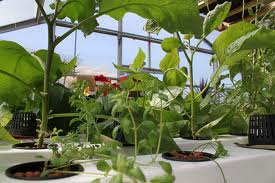 Typically, we share ideas and strategies on storing grains and other food as part of our overall preparedness strategy. Obviously, storage foods have a limit to their effectiveness. We should have other plans in place for a long-term preparedness solution.
Typically, we share ideas and strategies on storing grains and other food as part of our overall preparedness strategy. Obviously, storage foods have a limit to their effectiveness. We should have other plans in place for a long-term preparedness solution.
Every family that has a preparedness plan, should include planting and growing food as part of their plan. Land space obviously becomes a concern, so some alternative growing methods needs to be considered. That raises the question then – should you consider hydroponics in your preparedness planning?
Let’s look at some thoughts on hydroponics farming and growing:
Traditional farming makes people plant crops over a parcel of land, give the crops water to help them grow, then collect the crops when the harvest comes. This method has been used for many years and has been effective in providing food for families. Until, the need for food has expanded greatly which has pushed scientists to look for various other methods to increase production.
Unfortunately, some of those practices and new growing methods have not been particularly welcome. Many new practices have included using pesticides and herbicides, fertilizers, polluted sewage sludge and irradiation. Considering that these techniques are hazardous to good health and wellness, people have actually returned to organic farming that does not utilize any of these techniques.
Technology has actually discovered an additional means to increase crop production without threatening the wellness of individuals and the environment. This can be done by hydroponics farming. The method can utilize less space than typical farming methods, and actually produce more (and healthier) plants.
Plants require water to grow and produce, however this is only one component of a growing model. The various other components (and most important) are the nutrients that are utilized by the plant to grow. Researchers have discovered that it is just when this is diffused into the water supply that the roots of the crops consume the nutrients – making the plants and food grow.
By doing this in a regulated environment such as a greenhouse, the nutrients can already be mixed into the water supply permitting the crops produce more yields which is what hydroponics gardening is all about.
To prove how efficient it is, scientists made a comparative study on the growth of tomatoes. One batch utilized dirt and had the ability to produce 10 loads. The other batch used hydroponics and was able to produce 60 tons. This study shows that this hydroponics farming approach can produce 6 times more than conventional farming.
Practically any sort of plant that is grown using this way will produce high yields. Though some crops will be able to produce more than others, the length of time to harvest it is still faster than the old technique which gives a quicker turn-around time for farmers. In a preparedness strategy, that’s an important benefit. The faster we can produce a crop (with a higher yield) the better.
The farmer does not have to constantly examine the fields and take out weeds, till the land or look for plant illnesses that generally take place during soil cultivation since there are none. Some people might think that this will consume a lot of water but it doesn’t because it is recycled which also conserves less than traditional farming.
The trouble with a controlled environment is that the plants may not have the ability to get the correct sunshine and carbon dioxide that to help it grow. This trouble can be addressed by installing lights and instilling artificial CO2 into the air.
There are various other ways to grow crops while inside a greenhouse. One approach is called deep water culture. The roots of the plants are raised in the air and a pump releases air out to make it grow. This is optimal for grapes and other crops that grow in this way.
Another technique really like deep water culture is aeroponics. The plants are likewise raised in the air and nutrients below are blended in the form of a fog (or mist) which also reaches the crops to help them get the necessary nutrients to grow.
In flood and drainpipe, a tray is utilized to hold the nutrients. The roots of the plants are held by foam chips or clay pebbles then at particular times of the day, this is swamped so that the plants are able to receive the proper requirements for it to grow. Afterwards, this drains itself out.
Plants can likewise be expanded utilizing films. This method is called nutrient movie technique where light proof plastic is used. This flow along the passage way offering the crops the fundamentals it should grow.
There are lots of techniques to utilize hydroponics in the farm or in the house. The individual just has to inspect exactly what is needed and to think about what plants to grow.
Among the nicest things about hydroponics gardening is that it does not take a great deal of space. This permits the person to establish a greenhouse in the backyard. The only things needed are water in containers, tubes to recycle the water consumed by the plants, sturdy lights to be utilized as fabricated light and some organic nutrients that are readily available at the gardening shop.
Hydroponics has actually been around for virtually 30 years. By getting some details and the appropriate products, the individual can soon plant vegetables and fruits instead of buying it at the neighborhood grocery or supermarket.
There is a new magazine to help you in your preparation strategies. The magazine is called: PREPARE Magazine. In PREPARE, we discuss many alternative growing methods, as well as other helpful storage and self-reliance systems. Get a free one-year subscription to PREPARE by going to: www.preparemag.com/subscribe
Related Content
Auto Amazon Links: No products found.




